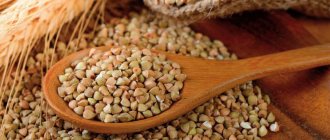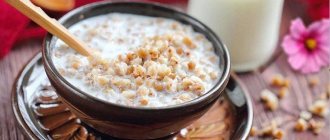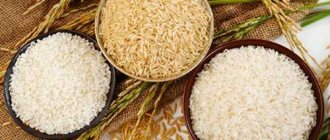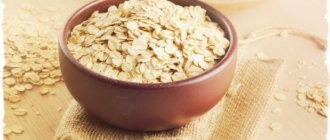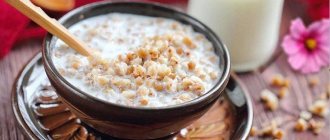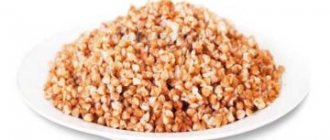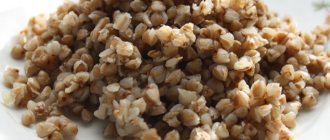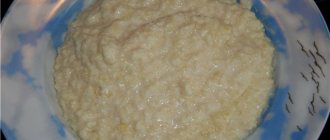Newborn babies are fed either formula or breast milk. At six months, the baby begins complementary feeding. Vegetables and cereals are considered good options. Buckwheat porridge for a baby as a first introduction to cereals is the best solution. Provided that all norms and proportions of administration are observed, the baby will not experience any adverse reactions to the products.
Buckwheat for babies
The benefits of buckwheat porridge for a child
The value of buckwheat for a child’s body is very high:
- complex carbohydrates provide energy;
- proteins contribute to the development of bone and muscle tissue;
- fiber improves digestion and absorption of nutrients;
- acids help the gastrointestinal tract and increase immunity;
- fats normalize cholesterol levels and improve metabolism;
- the heart and blood vessels are strengthened, anemia is prevented;
- Buckwheat is considered a hypoallergenic product.
Important! According to Evgeny Komarovsky, a famous Russian pediatrician, buckwheat is considered one of the most ideal options for first complementary foods. The doctor recommends not taking store-bought versions from popular companies, but preparing it yourself at home. You can easily make flour from purchased cereals, which you can then use to prepare porridge for babies.
Nutritional value
Contains:
- important elements for the full development of the child’s body;
- vitamins, micro- and macroelements;
- iron, phosphorus, honey and iodine;
- fibers and amino acids, vegetable proteins.
The benefits of buckwheat
Buckwheat contains a lot of proteins and amino acids, which are needed for the growth and strengthening of muscle and bone systems. It contains a storehouse of vitamins: PP, E, A and group B. Buckwheat contains so much iron that it surpasses some types of meat. It is indispensable for iron deficiency and other types of anemia, as well as for weak immunity and general exhaustion.
Buckwheat porridge will saturate the growing body with polyunsaturated fats (here they are at least 70%). They normalize cholesterol levels, have a beneficial effect on metabolism and normalize stool. Due to the abundance of polyunsaturated fats, buckwheat is useful for giving to overweight children.
How to choose cereal
Hercules decoction for infants with milk and water
Before you learn how to prepare buckwheat porridge for babies, you need to choose it correctly.
Rules:
- The cereal should be light in color. It is better if it is raw, green buckwheat, grayish in color. After frying, it acquires a darker, chocolate color, and light grains indicate that the cereal has undergone minimal heat treatment, retaining all its beneficial properties.
Green buckwheat
- It is better to choose a kernel rather than a chop. Whole grains (kernels) contain more vitamins needed by the child’s body. Chopped meat is more suitable for viscous porridges. There are also flakes that are not at all suitable for first feeding due to the damaged grain after industrial processing.
Additional Information. The quality and taste of the product depend on storage. After purchasing, be sure to pour the buckwheat into a glass or ceramic container.
How to grind
Child 10 months old - sleeps poorly at night, often wakes up and cries
There are two ways to grind cereal at home:
- Using a coffee grinder, you can quickly turn buckwheat into flour.
- Using a blender. However, it is worth noting that it must be of sufficient power.
The required amount of cereal is poured into a blender or coffee grinder, and the start button is pressed. As a rule, the grinding process is fast. If the appliance gets hot, you should let it rest for a few minutes. After grinding, the volume of the product will decrease slightly, unlike the original.
Grinding process
Time of introduction to complementary foods
At what age should a newborn baby be swaddled?
When a child can be given buckwheat depends on the following factors:
- Type of feeding a baby. For infants who have been formula-fed, it is permissible to introduce cereals earlier than six months, or, if the baby has a large weight gain, cereals are offered, on the contrary, later.
- Individual intolerance. If the baby is allergic, then before fully introducing porridge into the diet, his initial reaction should be monitored. Buckwheat is rare, but can cause allergies.
Complementary feeding table, WHO recommendations
As a rule, buckwheat is introduced into complementary foods immediately after vegetables, at 7-8 months of a child’s life.
Note! Buckwheat does not contain gluten. Those cereals that contain gluten should be included in the child’s menu after one year. Introducing barley groats is permissible from 1.5 years of age, and pearl barley - from 3 years of age.
How to cook buckwheat in water
How to prepare buckwheat for babies - cook ready-made, but it is better to grind the cereal yourself. Older children can be given unground product.
Options:
- Ready-made dishes from well-known companies: Hipp, Gerber, Nestle. If the choice falls on such a product, you should carefully study the composition to ensure the absence of sugar, GMOs and additives;
- Rubbed through a sieve;
- Classic, subsequently whipped with a blender;
- Porridge made from homemade flour.
How to cook correctly
How to cook ground buckwheat for babies:
- In a saucepan;
- In a multicooker on the appropriate mode.
If you don’t have a coffee grinder, you can prepare buckwheat in the classic way, and then beat the mass in a blender. If the porridge turns out to be too viscous, you should add a little broth.
Step-by-step preparation from whole grains:
- Sort the cereal for debris and unrefined grain:
- Rinse it several times;
- 1 teaspoon of cereal is poured into 100 ml of water, when the latter boils, the cereal is cooked over low heat for about 15 minutes;
- Cool to 37 degrees;
- Grind in a blender;
- Add either decoction or expressed milk. But only into cooled porridge.
Important! Cow's milk and salt should not be added to the first feeding dish.
There is nothing complicated in the recipe for porridge made from buckwheat flour for babies:
- Pour 4-5 tablespoons of flour into a bowl;
- add the amount of water that is suitable for the desired consistency of the finished dish.
Note! It is worth diluting the flour just before use. You cannot leave the finished product in the refrigerator.
Buckwheat flour recipe
Buckwheat flour porridge for babies is healthy and tasty. The grain in such a product retains its sweetness, and the absorption of all microelements occurs faster than in the case of whole grains. To get buckwheat flour, just grind the grain in a blender or coffee grinder.
Buckwheat flour
Cooking such porridge is not difficult, but it is very troublesome, since it costs only a small amount to prepare. The dish is not cooked for future use; only fresh product is offered to infants.
Buckwheat for children with cheese and butter
Peeled and washed buckwheat is boiled in water in a ratio of 1:3 for about 15 minutes. Remove from the hot plate and cover, leaving to rest for 10 minutes.
While the cereal is cooling, add a teaspoon of butter and desalinated cheese (Ricotta, Mozzarella, Cheddar, etc. If the cheese seems too salty, a piece can be soaked in water and only then given to the baby). A very healthy and nutritious dish for kids.
Standards for buckwheat porridge by month
As with all dishes in the first complementary feeding, the rule for buckwheat is to start with a small dose. At 7-8 months, after the baby has tried vegetable decoctions and purees from them, he is offered a spoonful of porridge in the morning. Then observe the reaction. If none is detected, the next day it is allowed to give 2 times more. Gradually, the volume of the product, depending on age, becomes 100-200 grams.
Important! The first porridges on a toddler's menu should be buckwheat, rice or corn.
How often to give
Baby food should be balanced and varied. It will be complete if the diet contains various types of cereals, vegetables, fruits, meat and dairy products. Buckwheat porridge alone on the menu will not provide a growing child’s body with all the necessary substances.
You should give buckwheat to your baby no more than 2-3 times a week to avoid unpleasant consequences such as difficulties in bowel function, flatulence and increased gas production.
Note! Excessive consumption of porridge leads to dehydration due to the fact that buckwheat “absorbs” excess water. For this reason, the product is recommended for people with excess body weight and pronounced swelling of the body.
Quantity
First feeding - 1 teaspoon. By the first year of life, the amount of buckwheat porridge reaches 100 grams per dose. Children can eat cereal at any time, even for dinner. Porridge contains easily digestible protein.
What to combine with
First, the baby must get used to single-ingredient porridge. Subsequently, you can offer an option from different grains - this way the body will be enriched with useful substances. It is permissible to add vegetables, fruits, and butter (3-5 grams) to the cereal.
Important! The very first complementary food should not contain any foreign components other than cereal or flour.
Buckwheat with carrots and herbs
From the infancy of parents, they are accustomed to giving their children porridge with milk. Modern dietetics has proven that milk and cereal are incompatible products. Grains are complex carbohydrates that require a lot of energy to digest. Completely different enzymes are needed to process milk. Thus, digestion worsens or prolongs after consuming milk porridge. In addition, buckwheat removes fats from milk, and this negatively affects the baby’s health.
Cream soup of zucchini and buckwheat
2 tablespoons butter 1 lemon leek 2-3 zucchini 3 tablespoons buckwheat 2 cloves garlic pinch thyme - dry
2 tablespoons yogurt 1 tsp. flour
Stew finely chopped leeks in butter, add thyme, add hot water, and after cooking, add chopped zucchini and well-washed buckwheat. Finally, add the garlic.
Make a sauce from yogurt and flour and add to the soup. Serve with chopped parsley.
If you are not a fan of flour, you can serve the soup with 1 tsp. low-fat sour cream per serving.
Possible problems when feeding porridge
If you introduce cereal too early or give it in large quantities, the following points may occur:
- Constipation. Since buckwheat removes excess fluid, intestinal permeability worsens;
- Bloating;
- Increased gas formation;
- Allergic reaction;
- In children with neurological diseases, the stool may change - black bile and mucus appear.
Buckwheat porridge is a valuable and healthy product. The best option for preparing it for children would be cereal or its crushed version in water. It is necessary to select the correct volumes of the finished dish, then no problems will arise.
Rules for this complementary feeding
Pediatricians advise giving porridge for the first time during morning feeding, when the baby has just woken up and is quite hungry after the night. It should be noted that we cook buckwheat without adding salt or oil, and it is advisable to refrain from sugar. Let your child try the natural taste of this product.
First complementary food - buckwheat dairy-free porridge
For the first time, you can use ready-made porridge bought in a store. It will save your time and is more convenient to prepare. In such porridges, only fresh cereals of high quality are used, and they are already processed and crushed to the required size.
When choosing which brand of porridge to purchase, carefully study the composition and cooking instructions. It is advisable to purchase porridge without added salt and sugar. Otherwise, the baby may get used to this taste, and in the future he will refuse porridge cooked by his mother. They will seem tasteless to him.
If you have already decided to purchase such a product in the store, then I recommend starting with dairy-free cereals. Once your baby gets the hang of it, you can move on to other options. There is no milk in this porridge, thanks to which we minimize the risk of an allergic reaction. In addition to buckwheat flour itself, dairy-free porridge includes: bifidobacteria, vitamins, lecithin and minerals.
And here you may be wondering, how to dilute buckwheat porridge for the first feeding? As a rule, you can read this information on the box. For example, when using Nestlé porridge, you need to dilute one tablespoon of porridge in 60-70 ml of water. But Heinz porridge recommends taking 200 ml of water per three tablespoons. We tried the first and second options. The second porridge turned out to be quite liquid and, frankly speaking, not very tasty. Therefore, I give my preference to the first manufacturer.
